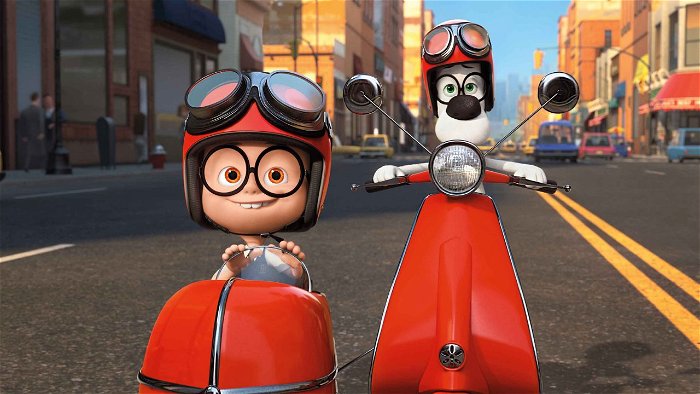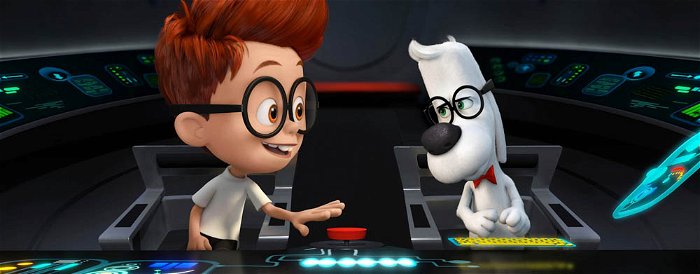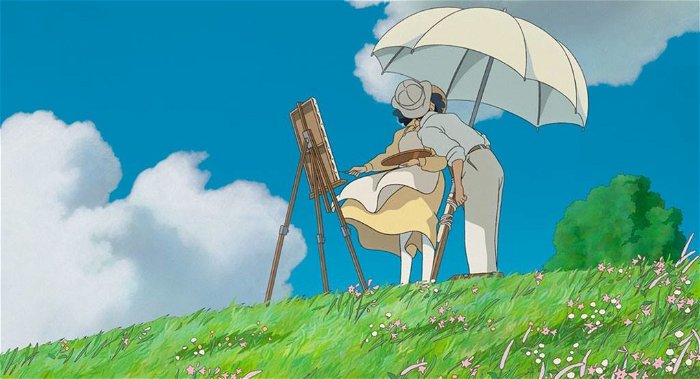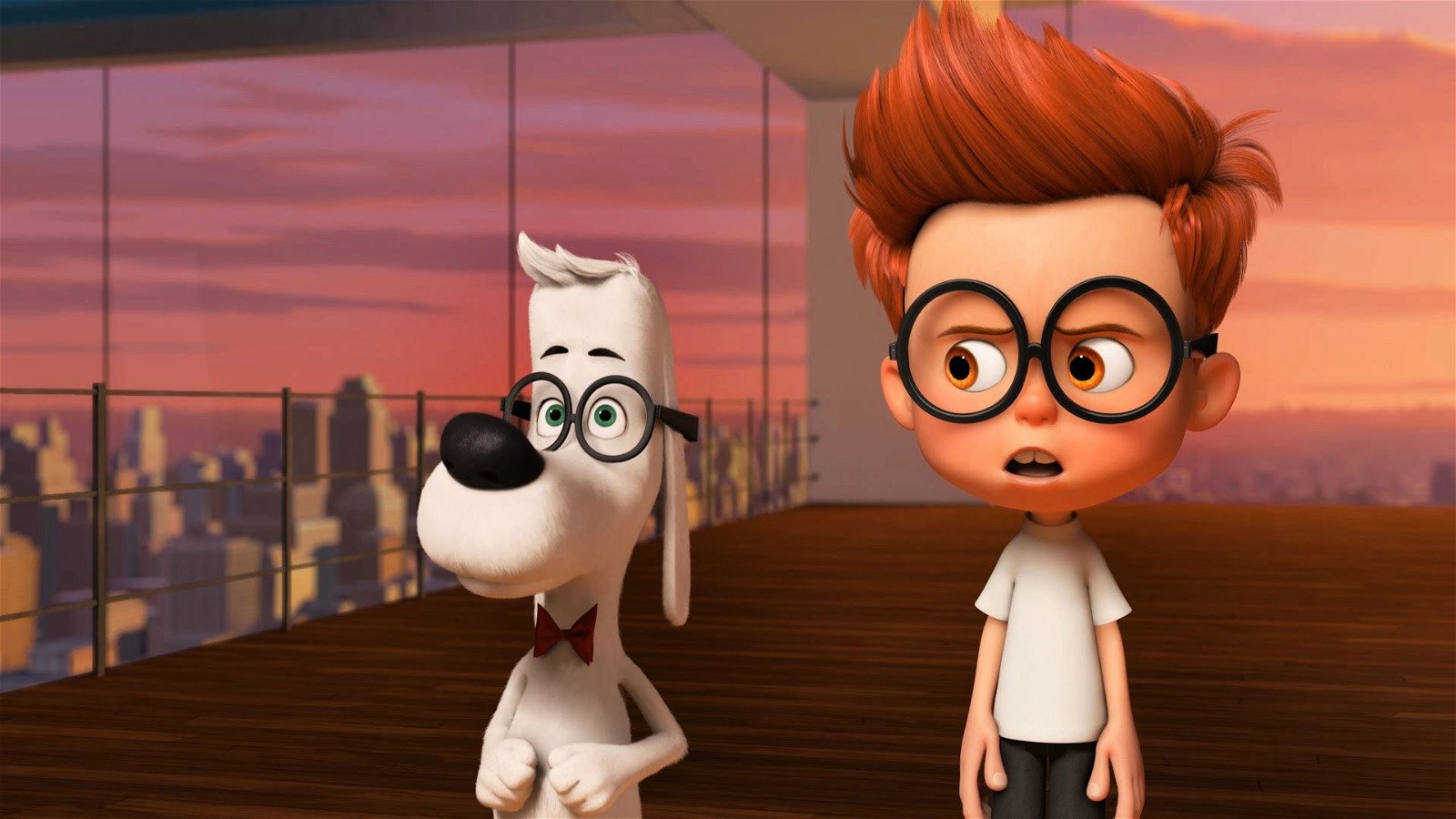For anyone who grew up on a steady diet of Jay Ward’s classic Rocky & Bullwinkle show, hearing the names Mr. Peabody and Sherman always brings on a smile.
The super-genius dog, his adopted human son, and their time-traveling adventures were a fixture of irreverent humour for generations of children and probably also inspired the adventures of Bill & Ted as well. Hearing that they would get a feature-length CGI feature was cause for concern for most of these grown-up children, given that previous attempts to adapt Jay Ward’s work to the big screen led to disasters like the Robert DeNiro-starring Rocky & Bullwinkle debacle and Dudley Do-Right. Thankfully, animation snobs and Jay Ward aficionados can calm down because the feature film edition of Mr. Peabody & Sherman is easily the best and most faithful Jay Ward adaptation to date. For that, we can thank one man: director Rob Minkoff.
Not just a Jay Ward fanboy-turned-filmmaker, Minkoff is one of the finest animation directors of his generation. He got his start on the early 90s Roger Rabbit animated shorts for Disney like Roller Coaster Rabbit and Tummy Trouble, eventually working his way through the Disney system to direct the classic feature The Lion King. From there he’s gone on the helm the Stuart Little movies and even the Jackie Chan/Jet Li picture The Forbidden Kingdom.
However, for over a decade Minkoff has been hammering away on his dream project of a Mr. Peabody & Sherman movie and now it’s finally here. CGM recently got a chance to chat with Minkoff about the project and his career, touching on everything from the challenges of adapting Jay Ward’s shorts into a feature length CGI blockbuster, the death of 2D animation, and the Roger Rabbit sequel that never was.

First off, based on the movie, I’m assuming you’re a huge fan of Jay Ward since you managed to get his tone exactly right. So was this a project that you spearheaded?
Rob Minkoff: Yes. It all started with a very simple conversation 12 years ago. I was working on Stuart Little and my producing partner Jason Clark—who has been working with Seth MacFarlane on Ted and A Million Ways To Die In The West—came to me one day and said, “What do you think of Mr. Peabody & Sherman?” I said, “I Love Mr. Peabody & Sherman.” He said, “Well, what about making a movie?”
I loved the idea, so then we met with Tiffany Ward, who is Jay Ward’s daughter. We decided to work together right away. There was no screenplay or anything at that point, so we started this epic saga. We took it to this company called Walden Media, who are famous for the Narnia movies. We met with Alex Schwartz who is an executive there and they wanted to do it. Then a whole bunch of things happened that made it impossible to do it entirely with them.
So we needed another partner and that’s when we ended up with Dreamworks. At first I didn’t think that would be possible because all of Dreamworks’ animated movies are homegrown and this was a preexisting property. So, I sort of avoided them but finally we tried and they liked it. That was in 2005. So then, we started on the quest of developing the movie with several different scripts and stories.
Yeah, that part must have been tricky. Since there’s no real backstory to these characters, being able to flesh that out in a feature is both a great opportunity and a big potential pitfall with the tone being this irreverent.
Rob Minkoff: Well, what’s interesting is that the adoption backstory is in there, but other than that you’re right. It is wide open. What do we know? Mr. Peabody is a genius. We know that. We know that he’s won Nobel Prizes and that he’s won Olympic Gold Medals. All of these incredible things. He’s the Woof Of Wall Street (Laughs), which we decided to leave out because of the other movie. But we know that he lives with his adoptive son Sherman in Manhattan and they have a Way Back Machine that they use to go on time traveling adventures. Those are all in the movie, obviously.
So the things that we did to expand on it, wasn’t to change things per se. It was just to build on what there. You know, like what is it like when they are at home? Things like that were never shown in the original and were wide open to explore. We wanted to look at this unusual family. We didn’t try to change it, just look at it from the point of view of today.
How would people react to a dog adopting a boy and the topic of unconventional families. The important thing was that we were making this today and we didn’t want to change it from what it was, because for me it was a timeless classic.

I’ve heard that Dreamworks likes to hire a lot of LA comedians like Patton Oswalt to punch up the humor in their animated movies. Was that the case here?
Rob Minkoff: We asked Patton Oswalt and he refused. We aren’t sure why. But we had some great people. Obviously Craig Wright is credited and he was fantastic who contributed a lot of material to the movie. Do you know Thom Lennon and Robert Ben Garant?
Of course. From Reno 911?
Rob Minkoff: Yeah, they helped a lot and that was pretty much the whole package of writers. And then, of course, there was the story team who contribute a lot and me too. It’s a collaboration. Craig is the only one who managed to get on the poster, but Ben and Thom contributed a lot of jokes.
Was it difficult to replicate both the tone and art of Jay Ward in a CGI blockbuster? Because his work is so specific and you nailed it, but at the same time it has a very old fashioned animation quality that obviously a CGI feature won’t have.
Rob Minkoff: Well, looking back at what he did, the art was a function of the budget. He was working with a very low budget for television, so I think the focus was making the scripts as funny and interesting as possible. The voice acting was amazing as well. The art is generally funny. That was the big thing. A funny drawing would sell the ideas, not the movement or animation. A lot of people asked me when they found out I was doing this, “Are you going to do it in 2D with intentionally bad drawings?” The only thing I really wanted to be true to was the content of the show.
The movie was going to be a movie for today and in CGI. As simple as the show was, the film would be more complicated. But at the same time, we wanted the imagery to be reminiscent of the era. We wanted his apartment to retain that classic look. We wanted to show our love for the original by carrying over the shapes of his art style and certainly the character designs. If you look at the original now, you’re just seeing a 2D rendering of what this is.
In fact, we produced a little piece that’s really awesome of our Sherman watching the old show on television saying, “Gee Mr. Peabody, they sure look familiar.” And Mr. Peabody says, “Well Sherman, that’s us from 1959.” And then Sherman says, “But if that’s us, then who are we?” (Laughs) The whole idea was to hear our characters alongside the original voices and imagery to show that they do kind of exist in the same universe. It’s just that one is 2D and flat and the other is 3D.
Since you came out of 2D hand-drawn animation, does it frustrate you at all that the medium has essentially gone extinct. Not that I don’t enjoy CGI, it’s just a shame that it completely replaced old format.
Rob Minkoff: Sure. Well, you know, it’s interesting. Because two of the movies nominated for Best Animated Feature at the Oscars this year were in 2D: The Wind Rises and Ernest & Celestine…

Of course but there’s nothing made in Hollywood anymore.
Rob Minkoff: Right. There are people who I know who are hoping to make 2D animated films. So it’s certainly possible that it’ll come back. But you know, if you look at the history of Disney, early on they invented the multi-plane camera and doing complex shadows and tone maps to create a three dimensional illusion on their feature films. That’s really important because you want the audience to go into the world of the story and in 2D animation there were so many tricks used to create that three dimensional illusion.
Some animation purists back in those days were against it because they thought that animation should be flat graphics and anything else was a distraction. I think that for feature length storytelling, the audience wants that extra dimension to be pulled into the world. And the truth is that once the audience experienced CGI, there was no going back. I remember—when it started—thinking that CGI was cold and technical and would never replace 2D animation.
Well, it has evolved incredibly over the last 20 years and has become a really malleable tool that can do almost anything. It doesn’t look stiff anymore. We worked hard to make sure things could squash and stretch and do traditional animation techniques.
I think that computer animation has evolved to a point where it’s become a very satisfying medium for animators to use it to do what they want to do rather than the computer driving the train. I just think that once the audience has seen dimensional worlds, it’s a little hard to go back. Even when I look at The Lion King today, I see the paintings and the brush strokes. Which of course is beautiful in its own right.
Yeah, I guess I’m just charmed by that because it provides a handmade quality.
Rob Minkoff: No question, and it is charming, but I think that now for good, bad, or different progress is progress. We can lament the lost art of the past, but if you do look at those two things, it’s hard to deny that there is something spectacular about seeing a fully imagined world that looks real.
That quality is an enhancement to the experience of getting people to watch a movie about such fictional characters. These are cartoons, but you want the audience to believe they are alive and exist. If you can feel like you could reach out and touch the fur like you can in CGI, I think it does something to our lizard brain and makes the magic even somehow more magical.
I wanted to quickly ask about The Lion King, since you brought that up and it’s now 20 years old. Along similar lines, did you feel the same level of authorship on a movie like that as a contemporary CGI movie? Because I just noticed on IMDB before coming here that there were 29 writers credited as well as a second director.
Rob Minkoff: Really? No, that’s not right. The only credited writers were Linda Woolverton, Jonathan Roberts, and Irene Mecchi. I contributed plenty and didn’t get credit, same with [co-director] Roger Allers. My guess is the other names are from the story team. That’s a typical thing in animation. Once you get into storyboarding, the script is just a jumping off point. Many other people get involved and collaborate from there. They’re primarily illustrators, who, in a live action movie, would be less involved.
The script is generally treated more rigidly in live action because once you have your script and you’re shooting, you try to get what’s written. In animation, once you storyboard it, the movie takes on a life of its own and can change and evolve. That’s pretty normal. So even on Snow White you would probably find 27 story artists who were equally involved. That’s just part of the process and I absolutely feel I had as strong a role in The Lion King as anything else that I’ve made.

I loved the old Roger Rabbit shorts that you did at the start of your career and I read that you at one point were going to make the sequel?
Rob Minkoff: Yes, I was going to direct the sequel.
What was it possibly about?
Rob Minkoff: The one I was working on was kind of a prequel. It was about Roger Rabbit coming to Hollywood in search of his mother and then ends up mixed up with a woman who was a bit like Norma Desmond from Sunset Boulevard.
Well, that fits into the animation/noir world of the first movie.
Rob Minkoff: Exactly.




